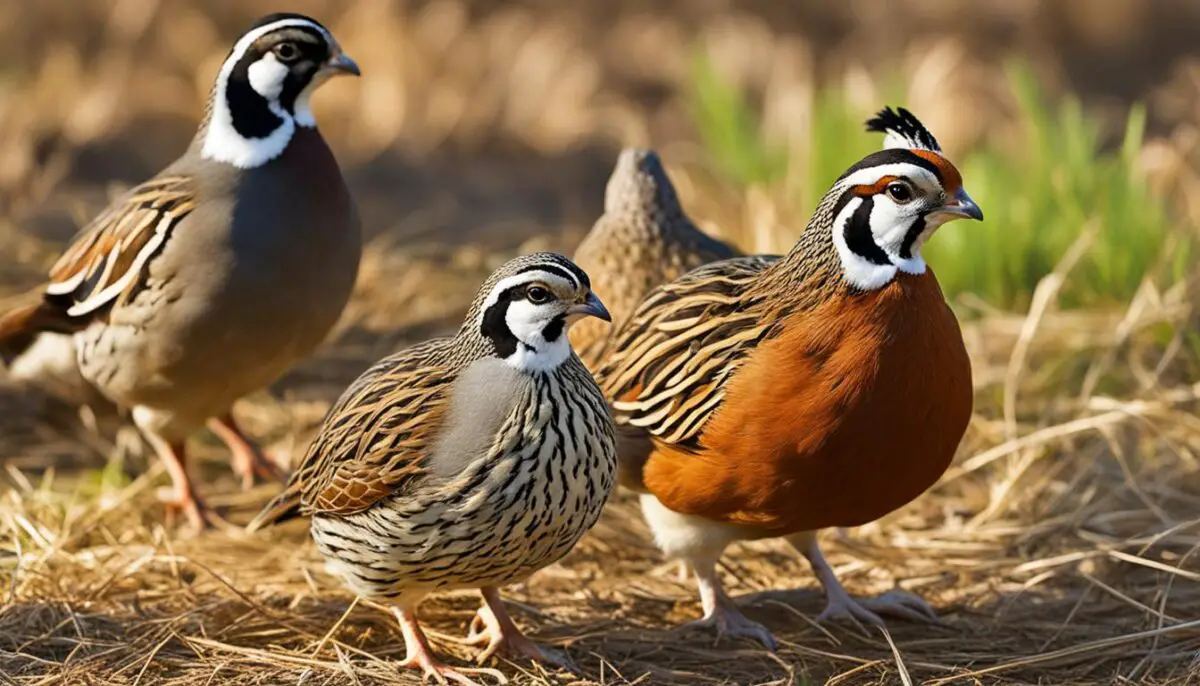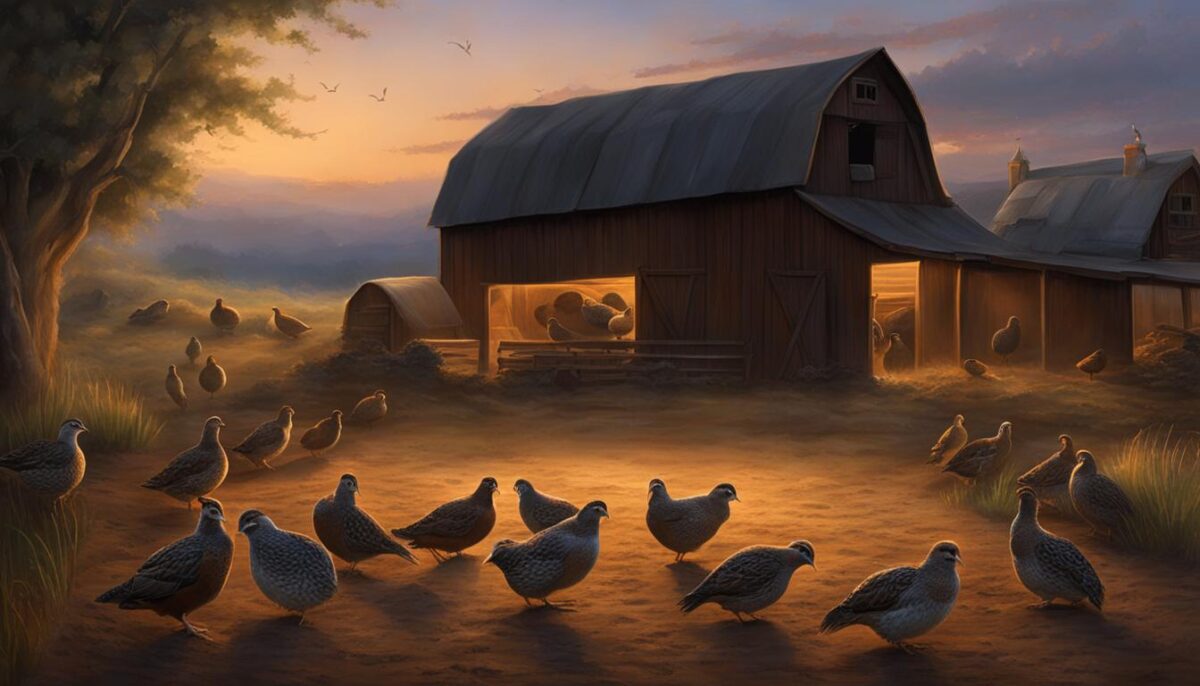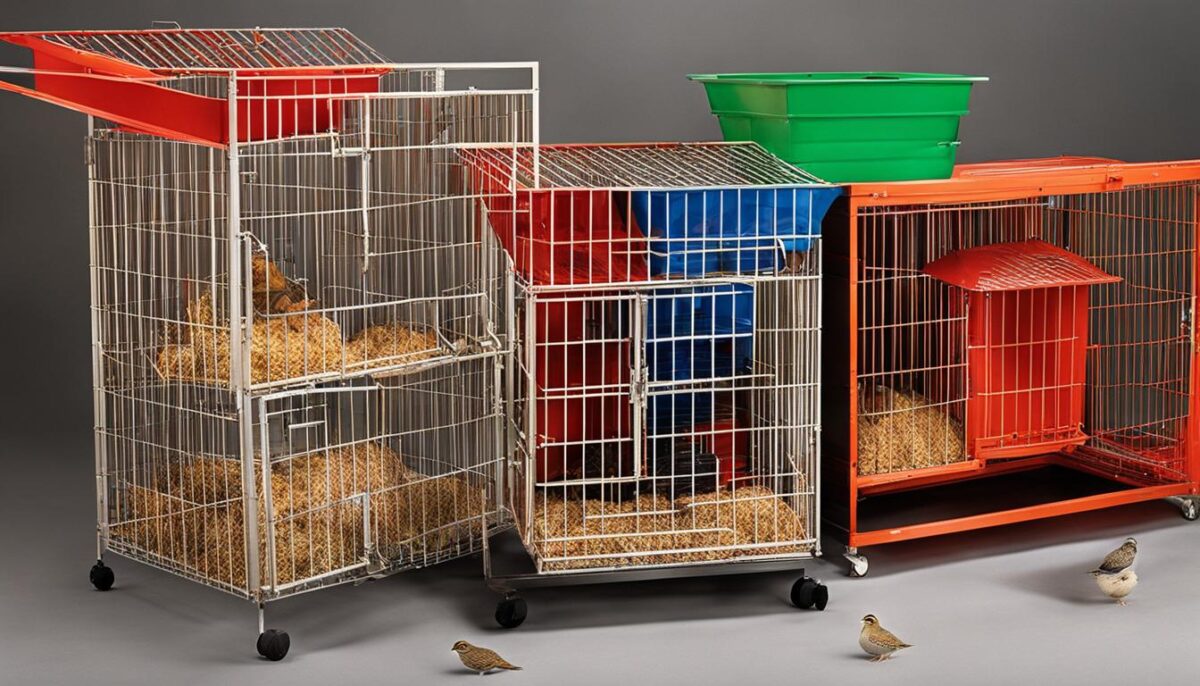Are you considering free-ranging quail in your farming endeavors? The concept of allowing quail to roam and spend time outdoors instead of confining them to cages has gained attention and sparked debates among quail keepers. While most quails kept for egg production are typically housed in battery cages, free-ranging quail farming offers both benefits and challenges that need to be carefully considered.
Key Takeaways:
- Free-ranging quail refers to allowing quail to roam and spend time outdoors.
- There are benefits and challenges associated with free-ranging quail.
- Housing, predator protection, and disease control are crucial considerations.
- Choosing the right breed of quail is important for successful free range farming.
- Supplementing quail’s diet with high-quality feed is essential.
What Type of Quail Housing Should You Have?
Housing plays a critical role in the successful free-ranging of quail. It is important to provide a safe and secure habitat that meets the specific needs of quails while allowing them to engage in natural behaviors. When considering quail housing options for free-ranging, there are several factors to consider, including predator protection, hygiene, and disease control.
Predator Protection: Quails are highly susceptible to predation, both from ground and aerial predators. To protect your free-ranging quail, it is essential to provide secure housing. This can include constructing fences and netted enclosures to prevent predator entry and planting bushes and shrubs to provide hiding spots for the quail. It is also important to monitor and restrict the access of cats to the quail yard and provide a secure coop for them to rest at night, protecting them from nocturnal predators.
Hygiene and Disease Control: Maintaining proper hygiene and disease control measures are crucial when housing and maintaining free-ranging quail. Regularly cleaning the housing area and removing waste is important to prevent the buildup of bacteria and parasites. Implementing disease control protocols, such as quarantine measures and regular health checks, can help prevent the spread of diseases among the quail.
“Quail housing should prioritize predator protection and hygiene to ensure the safety and well-being of free-ranging quail.”
Table: Comparison of Quail Housing Options
| Housing System | Advantages | Considerations |
|---|---|---|
| Cages | – Maximizes space efficiency – Easy to clean and maintain – Provides good ventilation |
– Limits movement and natural behaviors – Requires proper hygiene and disease control measures |
| Hutches | – Offers protection against predators – Provides a secure resting place |
– Requires adequate space – May limit natural foraging and movement |
| Aviaries | – Allows quail to roam and forage – Promotes natural behaviors – Reduces the need for chemical intervention |
– Requires a large space and secure enclosures – Needs protection against predators – Protecting from extreme weather conditions |
| Recall Pens | – Enables training and recall of quail – Provides safe rest area |
– Requires training for quail to return – Limited space for free-ranging |
| Ground Pens | – Allows quails to indulge in natural foraging instincts | – Predation risk – Disease transmission from wild birds |
Benefits and Challenges of Free-Range Systems for Quail
Free-range systems for quail have both benefits and challenges. Allowing quail to roam and forage in outdoor settings can provide them with a more natural environment, increased mental stimulation, and enhance their protection instincts. However, free-ranging quail also exposes them to predators and increases the risk of disease transmission from other birds. It requires careful predator management and disease control measures to ensure the safety and well-being of free-ranging quail.
The benefits of free-range quail are numerous. By allowing quail to roam and forage in a more natural environment, they have the opportunity to exhibit their natural behaviors and fulfill their instinctual needs. This can lead to increased physical and mental well-being, resulting in healthier and more content quail. Additionally, free-ranging quail may have reduced stress levels compared to quail kept in confinement, which can have positive impacts on their reproductive performance and overall productivity.
“Free-range quail have the opportunity to explore their surroundings, engage in social interactions, and forage for a variety of natural food sources, which can contribute to their overall health and welfare.”
However, there are also challenges associated with free-ranging quail. One of the main challenges is the increased risk of predation. Quail are natural prey animals, and when allowed to roam freely, they are more vulnerable to attacks from predators such as foxes, hawks, and snakes. It is essential to implement predator management strategies such as the use of fences, netted enclosures, and planting bushy shrubs to provide hiding spots and deter ground predators. By ensuring proper predator protection, quail owners can minimize the risk to their birds and create a safer free-range environment.
Another challenge of free-ranging quail is the potential for disease transmission from other birds. When quail are allowed to interact with wild birds or other poultry species, there is a higher risk of exposure to diseases such as avian influenza and coccidiosis. Implementing strict biosecurity measures, such as keeping quail separate from other bird species and regularly monitoring their health, is crucial for disease control. Vaccinations and regular veterinary check-ups are also important to maintain the health of free-ranging quail.
| Benefits of Free-Range Quail | Challenges of Free-Range Quail |
|---|---|
|
|
Protecting Your Quail from Predators
Quail, whether free-ranging or kept in cages, are vulnerable to various predators that can pose a threat to their safety. Taking measures to protect your quail from these predators is essential for their well-being and survival. Here are some effective strategies to safeguard your quail from ground and sky predators:
Ground Predators:
- Plant bushes and shrubs around the quail yard to provide hiding spots and discourage ground predators from approaching.
- Install fences around the perimeter of the quail yard to prevent access by ground predators such as raccoons, foxes, and snakes.
- Use netted enclosures or hardware cloth buried underground to create a barrier against digging predators like skunks and opossums.
- Monitor and restrict the access of domestic cats to the quail yard, as they can pose a significant threat to the quail.
Sky Predators:
- Install bird netting or wire mesh over the quail yard to prevent aerial predators like hawks and vultures from swooping down and attacking the quail.
- Provide overhead cover, such as branches or a covered aviary, to create a sense of protection for the quail and deter flying predators.
By implementing these protective measures, you can significantly reduce the risk of predation and ensure the safety of your free-ranging quail.
Best Breeds of Quail to Raise
When considering free-ranging quail, the choice of breed plays a crucial role in ensuring their adaptability to outdoor environments. One of the most popular quail breeds for free-ranging is the Coturnix quail, also known as Japanese quail. They are easily domesticated and have flight instincts to a lesser extent compared to other quail species. Their adaptability to various climates and their ability to thrive in outdoor settings make them an ideal choice for free-range quail farming.
However, it is important to consider the potential risks associated with free-ranging multiple species together, especially in terms of disease transmission. Quails can contract diseases from other bird species, such as chickens, which can negatively impact their health and productivity. Therefore, it is essential to be knowledgeable about potential diseases and implement appropriate measures to prevent cross-species contamination.
Choosing the best breed of quail for free-ranging ultimately depends on various factors, including your specific farming goals, climate conditions, and available resources. It is recommended to consult with local experts or experienced quail farmers to determine the most suitable breed for your specific location and objectives.

Pros and Cons of Different Quail Breeds
| Breed | Pros | Cons |
|---|---|---|
| Coturnix Quail | Easy to domesticate, adaptable to various climates, suitable for free-ranging, good for meat and egg production | Potential risk of disease transmission from other bird species |
| Bobwhite Quail | Excellent hunting birds, well-suited for sports purposes | More flight-prone, require larger outdoor space, not as domesticated as Coturnix quail |
| California Quail | Beautiful plumage, good for ornamental purposes | Less adaptable to captivity and free-ranging, may require specific habitat and climate conditions |
By considering the specific characteristics and requirements of different quail breeds, you can make an informed decision about which breed is best suited for your free-range quail farming endeavors.
Nutritional Care and Feeding for Quail
Proper nutrition plays a crucial role in the health and productivity of free-ranging quail. While they have the opportunity to forage for their own food, it’s important to supplement their diet with high-quality game bird feed to ensure they receive all the essential nutrients they need. Quails require a balanced diet to maintain their overall well-being and to support their egg production or growth for meat purposes.
When it comes to formulating a feeding plan for free-ranging quail, it’s essential to consider their specific dietary requirements. High-quality game bird feed should be the primary component of their diet, providing essential vitamins, minerals, and protein. Additionally, incorporating fresh greens, fruits, and vegetables can provide additional nutrients and variety to their diet.
Feeding baby quails requires extra attention, as they are more vulnerable to predators and have specific nutritional needs. A nutrient-dense starter feed specially formulated for young quails is recommended to support their growth and development. As they mature, their diet can transition to a balanced game bird feed.
Table: Sample Daily Feeding Plan for Free-Range Quail
| Food | Amount |
|---|---|
| Game bird feed (16% protein) | Ad libitum access |
| Fresh greens (such as lettuce, kale, or spinach) | 10-15% of daily diet |
| Fruits and vegetables | 10-15% of daily diet |
| Calcium supplement (crushed oyster shells or eggshells) | Available at all times |
| Water | Available at all times |
Note: It’s important to monitor the quails’ food intake and adjust their diet accordingly. The provided feeding plan serves as a general guideline and can be adjusted based on the specific nutritional needs of your quails and the availability of forage in their free-ranging area.
Training Quail to Come Back in at Night
Training quail to return to their designated coop at night can be a useful practice for quail keepers who free-range their birds. Unlike chickens, quail may require some training to learn this behavior. By implementing recall training, quail can learn to come back to safety after a day of outdoor foraging. This training process can be achieved by keeping a few hens in the coop and gradually introducing the concept of coming back to the quail.
“Consistency, routine, and patience are key when training quail to recall and establishing a safe resting place for them at night.”
It is important to establish a routine and maintain consistency during the training process. Quail are creatures of habit and respond well to regularity. By creating a consistent routine, they will start associating certain cues with returning to the coop, such as the presence of the hens or the time of day. Over time, quail will learn to follow these cues and return to their designated coop at night.
Providing a safe resting place for quail at night is crucial for their protection against nocturnal predators. A secure coop with proper ventilation and predator-proofing measures should be in place to ensure the safety of the quail. By creating a comfortable and secure environment, quail will be more likely to return to the coop willingly.
Training Quail to Come Back in at Night – Step by Step Guide:
- Choose a designated coop or housing area for the quail to return to at night.
- Introduce a few hens into the coop to create a sense of security and familiarity.
- Gradually allow the quail to explore the outdoor area during the day, while keeping an eye on them.
- Encourage the quail to return to the coop by providing food and water inside.
- Establish a consistent routine and time for the quail to return to the coop.
- Monitor the quail closely during the training process and ensure their safety from predators.
- Be patient and persistent with the training, as it may take time for the quail to learn the behavior.
Overall, training quail to come back to their designated coop at night is a process that requires consistency, routine, and patience. By implementing recall training and providing a secure resting place, quail keepers can ensure the safety and well-being of their free-ranging quail.

Types of Quail Housing Systems
Quail can be raised in various housing systems, each with its own advantages and drawbacks. The choice of housing system depends on factors such as available space, desired level of predator protection, and the option for free-ranging. Here are some common types of quail housing systems:
1. Cages
Cages are commonly used to house quail, especially in commercial quail farming. Stacked cages maximize space utilization and facilitate easy cleaning. Commercial galvanized or welded-wire cages provide good ventilation and durability. Quail cages should have appropriate wire spacing to prevent injury and escape.
2. Hutches
Hutches are an alternative housing option for quail, providing a more secure environment against predators. Hutches are typically enclosed structures with wire mesh walls and a solid roof. They offer protection from ground-based predators and allow quail to exhibit natural behaviors. However, hutches may take up more space compared to cages.
3. Aviaries
Aviaries are larger enclosures that mimic the natural habitat of quail. They provide ample space for quail to roam, forage, and fly. Aviaries can offer a more natural and mentally stimulating environment for quail, promoting their overall well-being. However, building an aviary requires significant space and careful consideration of predator protection.
4. Recall Pens
Recall pens are specialized housing systems designed for training quail to return to their designated coop at night. These pens are usually semi-enclosed structures with a safe resting area for quail. They provide a controlled environment for quail to learn recall behavior while protecting them from predators.
When selecting a housing system for quail, it is important to assess the specific needs of the quail breed, considering factors such as space, predator protection, and the extent of free-ranging desired. A well-designed and suitable housing system is essential for the welfare and productivity of quail in both commercial and backyard settings.
Building an Aviary for Quail
Building an aviary for quail can provide them with a more natural and spacious environment, allowing them to roam and forage on the ground. It is important to create a secure and predator-proof structure to ensure the safety and well-being of the quail. When constructing an aviary, there are several key considerations to take into account.
Size and Structure
The size of the aviary will depend on the number of quail you plan to keep and the space available. A general guideline is to allow at least 5 square feet of space per quail. The aviary should be tall enough to accommodate the quail’s natural flight instincts, with a minimum height of 6 feet. The structure should be sturdy, made of materials such as galvanized wire mesh or welded wire, to prevent predators from entering.
| Aviary Size | Number of Quail | Minimum Height |
|---|---|---|
| 10’x10′ | 10-15 | 6 feet |
| 20’x20′ | 20-30 | 6 feet |
| 30’x30′ | 30-45 | 6 feet |
Enclosure and Roofing
The enclosure of the aviary should be secure, with no gaps or holes that predators could exploit. Buried wire mesh or hardware cloth can be used to prevent animals from digging under the perimeter. It is also important to provide a partially covered roof to protect the quail from extreme weather conditions and potential predator attacks from above. The roof can be made of materials such as corrugated metal or polycarbonate panels.
Double Door System
Implementing a double door system in the aviary can help prevent quail from escaping when entering or exiting the enclosure. This involves having two doors, with a small enclosed space in between, which acts as an airlock. This design minimizes the chances of quail escaping and provides extra security.
Building an aviary for quail requires careful planning and consideration of their needs. It provides a more natural environment for quail to thrive and can enhance their overall well-being. By following these guidelines and ensuring a secure structure, you can create a safe and enjoyable space for your quail to live and flourish.
Quail Cage Accessories
When it comes to raising quail, providing the right cage accessories can greatly enhance their well-being and overall experience. These accessories not only contribute to their physical health but also promote mental stimulation and natural behaviors. Here are some essential quail cage accessories to consider:
Quail Feeders:
Quail feeders are specifically designed to ensure that your quail have access to their food without wasting it or causing unnecessary mess. These feeders are designed to minimize spillage and make it easier for quail to access their feed, promoting efficient feeding habits. It is important to choose feeders that are suitable for the size of your quail and can hold an adequate amount of food.
Quail Waterers:
Proper hydration is crucial for the health and well-being of your quail. Quail waterers are designed to provide a constant supply of clean water, keeping your quail hydrated throughout the day. It is important to choose waterers that are easy to clean and maintain, ensuring that your quail have access to fresh water at all times.
Toys for Quails:
Providing toys and enrichment items in quail cages can help keep your quail active and engaged. Hanging balls, foraging toys, and other interactive toys can stimulate their natural instincts and prevent boredom. These toys promote physical activity and mental stimulation, creating a more enriching environment for your quail.
Dust Baths:
Quails naturally need dust baths to keep their feathers clean and healthy. Providing a shallow container with fine dust or sand allows your quail to groom themselves and maintain optimal feather condition. Dust baths also help control parasites and prevent skin issues, ensuring the overall health and well-being of your quail.
Bedding Materials:
Choosing the right bedding material for your quail cage is essential for their comfort and hygiene. Wood shavings, straw, or paper-based bedding can provide a soft and comfortable surface for your quail to rest on. The bedding material also absorbs moisture and helps control odors, creating a clean and odor-free environment for your quail.
Nest Boxes:
If you are raising quail for egg production, providing nest boxes is crucial. Quail nest boxes create a secure and private space for your quail to lay their eggs, ensuring that they are protected and comfortable during the egg-laying process. The nest boxes should be easily accessible and designed to mimic the natural nesting environment of quail.

| Accessory | Description |
|---|---|
| Quail Feeders | Designed to minimize spillage and make it easier for quail to access their feed. |
| Quail Waterers | Provide a constant supply of clean water to keep quail hydrated. |
| Toys for Quails | Keep quails active and engaged with interactive toys that stimulate natural instincts. |
| Dust Baths | Allow quail to groom themselves and maintain optimal feather condition. |
| Bedding Materials | Provide a soft and comfortable surface for quails to rest on, absorb moisture, and control odors. |
| Nest Boxes | Create a secure and private space for quail to lay their eggs. |
Conclusion
In conclusion, raising quail in a free-range system can be a rewarding endeavor, but it requires careful consideration and planning. The benefits of providing quail with a more natural environment and increased mental stimulation are significant. However, it is crucial to address the challenges associated with free-ranging, such as housing, predator protection, and disease control.
By implementing appropriate measures, such as building secure enclosures, planting shrubs for hiding spots, and monitoring predator access, quail owners can help protect their birds from potential threats. Additionally, having a well-designed coop for quail to rest at night is essential for their safety.
When considering free-range quail farming, it is important to choose the right breed, such as Coturnix quail, and be aware of potential disease transmission risks when raising multiple species together. Providing a balanced diet, supplementing foraging with high-quality game bird feed, and offering proper nutrition are key to maintaining the overall health and productivity of quail.
In conclusion, successful free-range quail farming requires a combination of proper housing, predator management, disease control, and training. With these considerations in mind, quail owners can create a welfare-friendly and productive free-range system for their quail that contributes to their overall well-being and success.
FAQ
Can you free range quail?
Yes, free-ranging quail is a viable option, but it comes with challenges such as predator protection and disease control.
What type of housing should I have for my quail?
Quail can be housed in cages, pens, hutches, recall pens, or ground pens, depending on your space availability and desire for free-ranging.
What are the benefits and challenges of free-range systems for quail?
Free-ranging quail can provide a more natural environment and increased mental stimulation but also exposes them to predators and disease transmission.
How can I protect my quail from predators?
Measures such as planting bushes, building fences, and providing a secure coop at night can help protect quail from ground and sky predators.
What are the best breeds of quail to raise?
Coturnix quail, also known as Japanese quail, are commonly domesticated and adapt well to free-ranging environments.
What should I feed my free-ranging quail?
Quail should be supplemented with high-quality game bird feed to ensure a balanced and nutritious diet.
How can I train my quail to come back in at night?
Recall training can be implemented by gradually introducing the concept of returning to a designated coop using hens as role models.
What are the different housing systems for quail?
Quail can be housed in cages, hutches, aviaries, recall pens, or ground pens, depending on your specific needs and space availability.
How can I build an aviary for my quail?
Building an aviary requires a large space, secure enclosures, appropriate wire or sheet materials, and a partially covered roof.
What accessories should I provide for my quail in their cage?
Quail cage accessories include feeders, waterers, toys, dust baths, bedding materials, and nest boxes to enhance their well-being and comfort.


